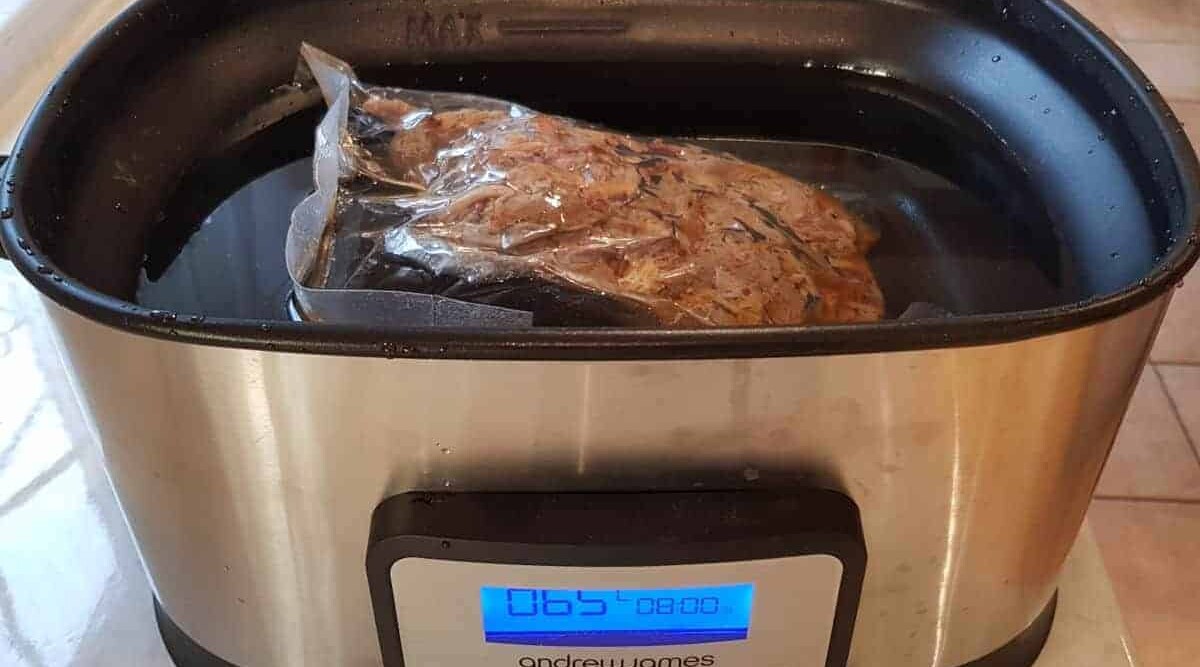
In this article, we’ll look at reheating pulled pork from two perspectives, cooking ahead and leftovers. We’ll cover what to avoid, common reheating methods, and consider options and controversies on the road to reheated pulled pork perfection.
Pulled pork is made from the upper shoulder of the pig; a large cut called the butt which can weigh over 11 pounds. Even with a portion lost to bone and fat, that’s a lot of meat and, unless you have many mouths over to help eat it, there will be leftovers.
And if you’re cooking ahead for a party or picnic, how can you bring a refrigerated or frozen butt back to hot and tender and ready for pulling?
Nothing beats hot off the grill; the goal is to get as close in flavor, moistness, and bark as possible.
Let’s find out how!
Jump to:
Saved to Savor Another Day
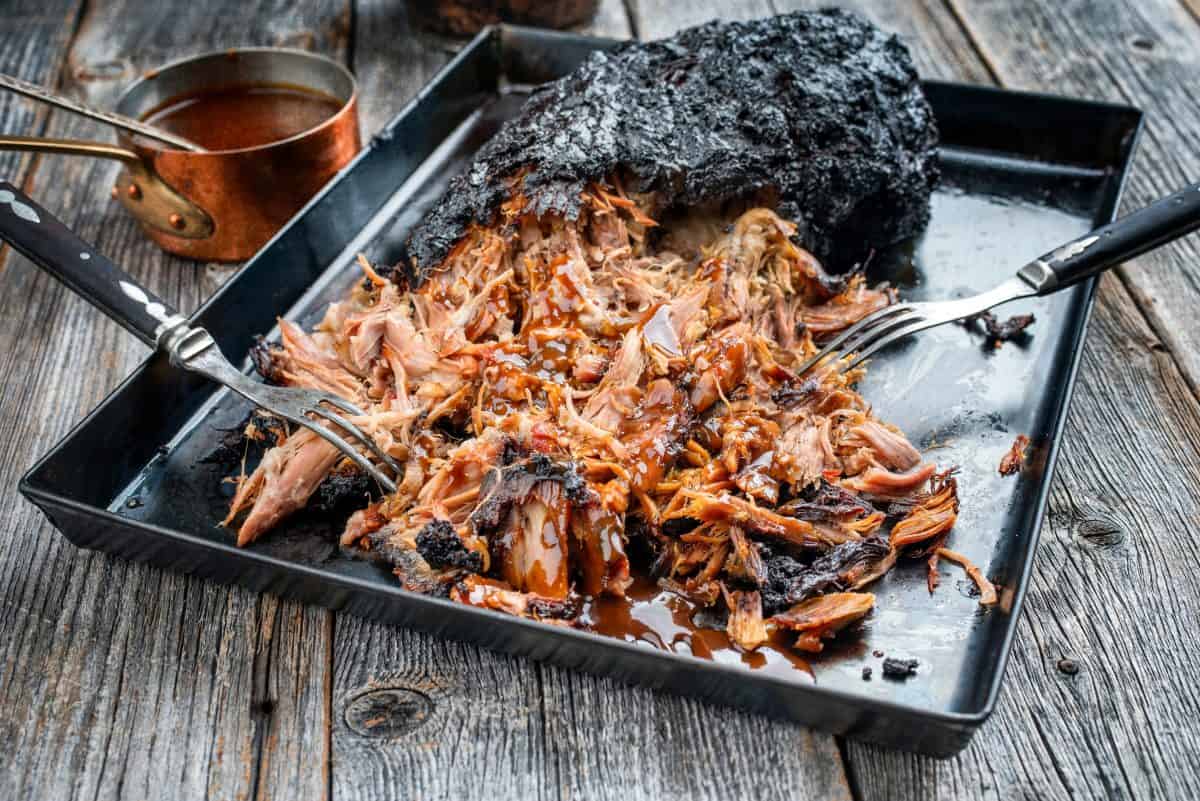
The meal was great, and you and your guests are happy and just about full. But there’s still a lot of pulled pork leftover. You watch with regret as it cools, losing its fresh cooked perfection. But you’re happy, contemplating how good it will be the second time around. Because you have a method, right?
If you don’t, keep reading. If you do, keep reading and let’s compare notes.
Before exploring storage and reheating methods, let’s consider a deadly danger to avoid at all costs: dried out pork.
Dangerous and Disappointing Dry-out
The dreaded dry-out is the bane of every cook’s existence. When freshly off the fire, Meathead Goldwyn waxes poetic on freshly cooked meat:
Hot juices, the connective tissues have melted and turned to luscious gelatin, the fat has rendered and lubricates the muscle fibers, browned surfaces are crunchy …
He then catalogs the dismal results of time and loss of heat: a loss of tenderness, juiciness, crispness (the bark), and flavor.
That being the case, the first step in moist and tender reheated pork is proper storage.
Storing Pulled Pork After Cooking
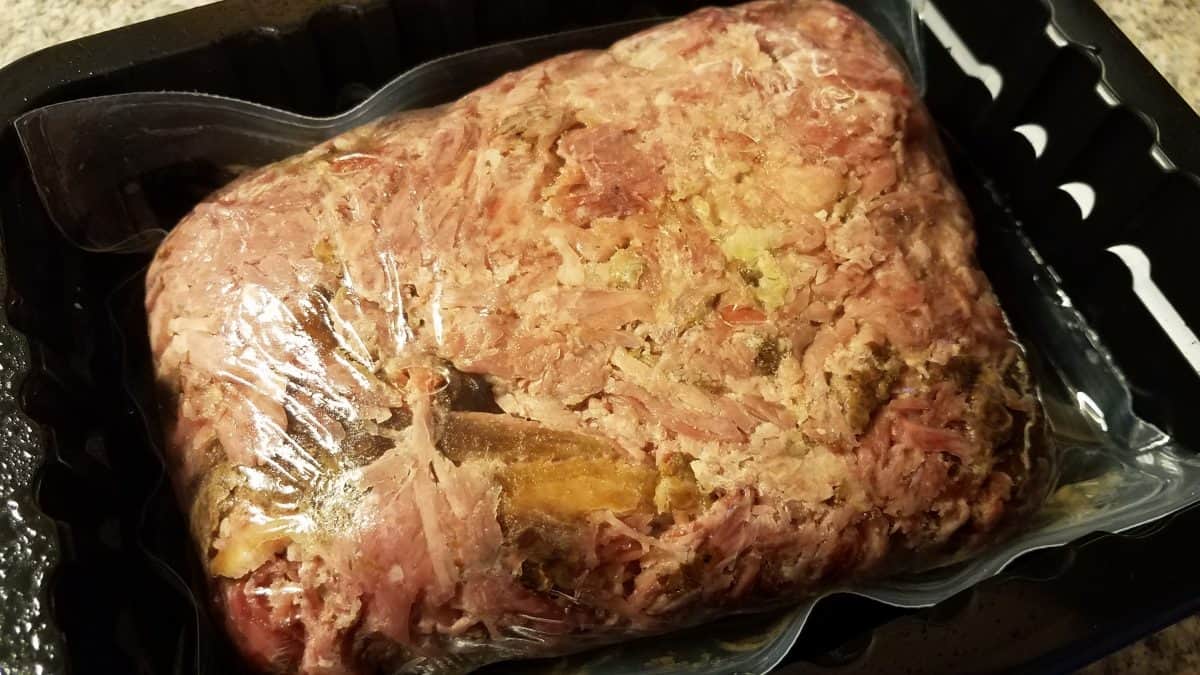
For the grilled in advance pork, keep it whole unless you know you’ll only have 15-20 minutes to reheat and serve. The longer it’s in one piece, the better it will hold onto its moisture.
If you’re going to pull before storage do so while the meat is still uncomfortably hot to the touch. You’ll have already invested in a set of heat-proof gloves, right? Here’s where they come in.
There are a couple of storage methods. They all involve minimizing air, sealing in moisture, and keeping safe temperatures, and necessarily require a fridge or freezer.
Wozniak Method — Originally developed by champion pitmaster Mike Wozniak, Meathead Goldwyn tweaked his method for cooking in advance:
- Once the pork has reached 175° F internally, tightly wrap it in aluminum foil. Be sure all edges are sealed off.
- Place foil-wrapped meat into a watertight plastic bag like a clean (fragrance-free) trash can liner.
- Bury in ice in a cooler.
- At this point, the meat is too hot for the refrigerator. It will raise the already-inadequate temperature of the fridge, taking stored foods out of their safe temperature ranges.
- Move the meat to the fridge when its temperature is in the 40s.
If you’re going to portion off the pork to be stored for multiple different meals, consult our guide on how much pulled pork to serve in each portion, so you can gauge correctly how much to put into each package.
Heating the Pork — Do it Low and Slow (After Defrosting)
The pork was cooked low and slow; that’s the way to reheat it. Doing so preserves the moistness and flavor.
Pulled or whole, a pork butt can safely be refrigerated at 40° F for up to 4 days. If it’s been a while since the pork was cooked, and it’s been frozen, step one is:
The Thaw
A cooked pork shoulder can be frozen 2 to 3 months, says the USDA Food Safety and Inspection Service. Beyond three months it will still be good; just not as tasty.
Completely thaw meat in the fridge, giving a full 24 hours to do so.
Reheating Pulled Pork — 4 Common Methods
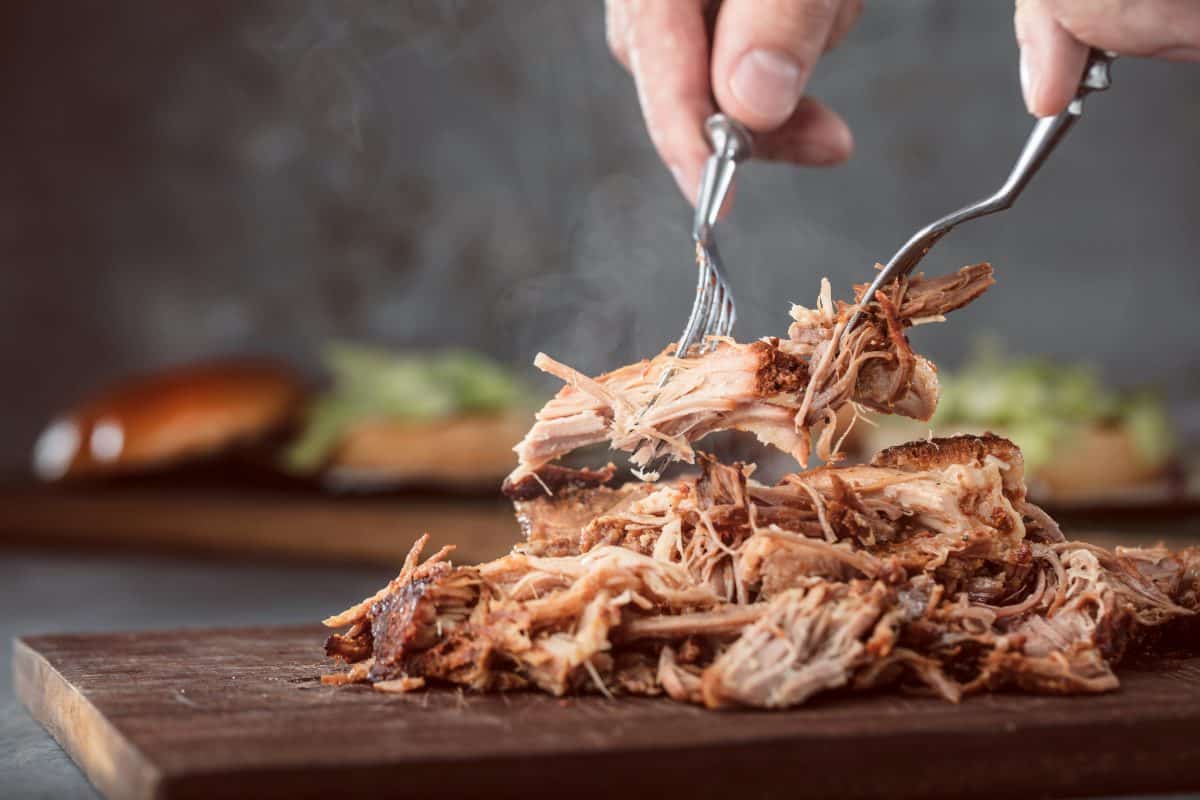
There are four commonly used methods, listed in order of preference:
How to Reheat Pulled Pork Sous Vide (pronounced soo veed)
Sous Vide is French for “under vacuum“. It is another indoor method, done in a special kitchen appliance or on the stovetop.
In sous vide cooking, food is vacuum sealed in a watertight bag and placed into a bath of hot water (never boiling water) for the required cooking time.
According to SeriousEats.com, a moist pork shoulder can result from cooking 18 to 24 hours and being finished on the grill or in the stove.
This method lends increased moistness to the finished product. Once cooked, the pork could be stored for up to a week in the fridge.

I have reheated pulled pork using all the methods in this guide. Sous vide — or a pan of water on the hob — is by far the best method, resulting in the highest quality, closest to freshly cooked, moist and delicious pork. Use this method if you can!
— Mark Jenner
But let’s stay with storing and reheating what’s come off the grill. It makes more sense to shred the pork before it’s frozen.
How much time you have before serving would likely be the biggest factor in choosing when to shred. Since it’s going into a hot water bath, thawing isn’t necessary.
- Place cooked pork into bags and vacuum seal
- Chill in an ice water bath for 45 minutes
- Freeze
When ready to serve:
- Bring a large pot of water to 165° F
- Immerse plastic bags for 45 minutes per inch of thickness
- If frozen, add 30 minutes
- Check the internal temperature and once of a minimum of 165 degrees Fahrenheit is reached, carefully remove from water bath and open bag
- If whole, pull pork and place on serving platter. Resting time is unnecessary.
How to Reheat Pulled Pork on the Grill
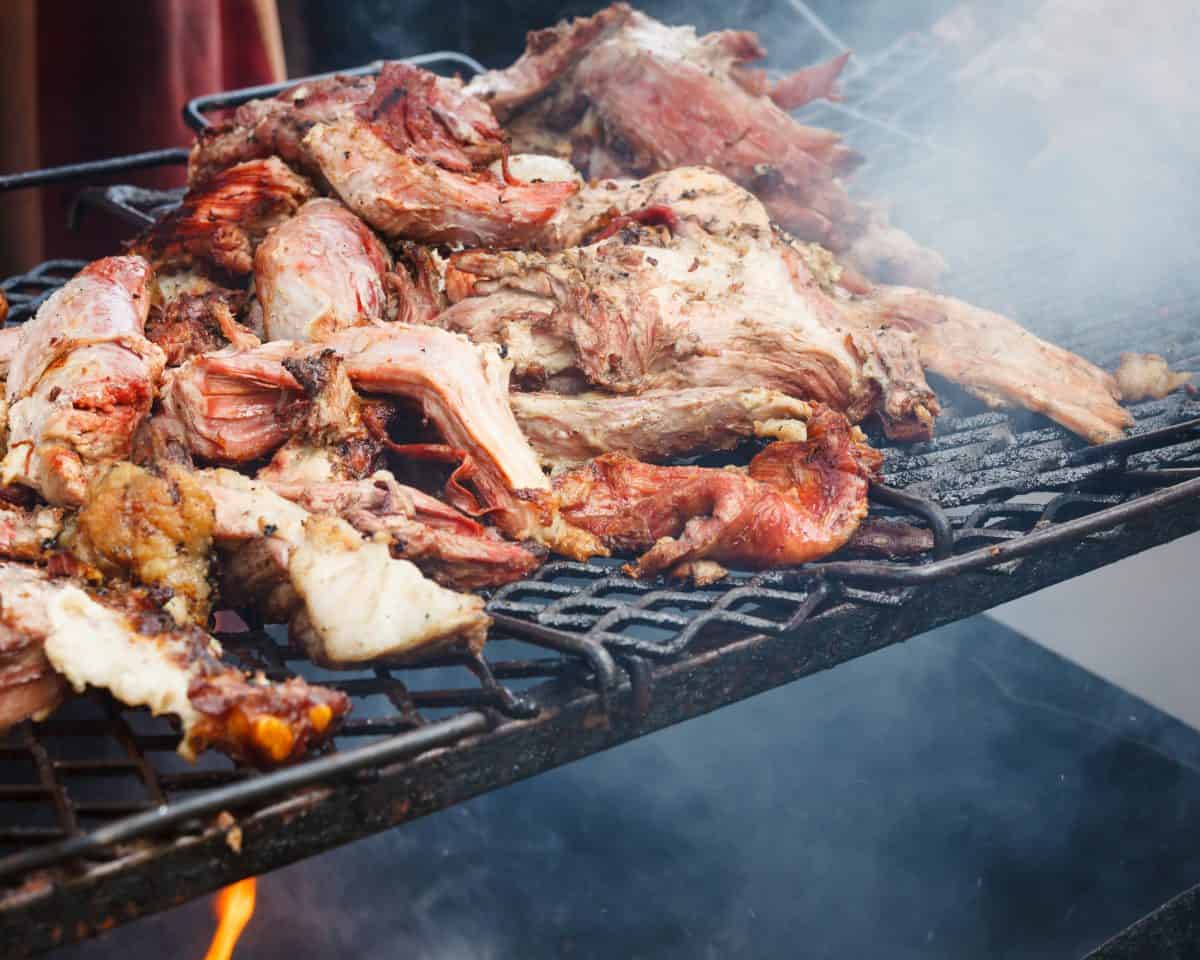
Using direct heat will leach the moisture from the roast, leaving a large blob of dry. Avoid this by using the 2-zone indirect cooking method.
If using a charcoal grill, arrange charcoal to one side of the grill. For gas grills, keep one or two burners unlit.
- Heat the indirect side to 225° F.
- Take the (thawed) meat from the refrigerator and coat with barbecue
- Wrap pork in two layers of foil, adding ¼ cup of water before sealing it up.
- Place over indirect heat until your grill or smoker thermometer reads 165° F.
- Unwrap and place over direct heat for a few minutes to crisp up the bark.
- Remove from grill, pull the pork, (check out our article on how to pull pork), and then serve.
Reheat it in the Microwave
Beyond the belief of diehard grillers that microwaving grilled food is sacrilegious, is the concern of chemicals from plastic contaminating foods. Harvard University set out to clarify this issue:
- Contrary to popular belief, microwaving in plastic containers will not leach dioxins (chemicals known to cause cancer) into your food. Plastic does not contain dioxin; burned things do. It’s why you don’t want to eat charred or burned food of any kind.
- Don’t use plastic wrap or storage bags because they, especially if in contact with fatty foods like meats, can leach two chemicals — bisphenol-A (BPA) and phthalates — used to help plastic hold its shape. These are known as endocrine disruptors — they interfere with how the body uses hormones, with seriously harmful effects. It’s with good reason that you now see plastic products promoted as BPA or phthalate-free.
- The U.S. Food and Drug Administration regulates containers made for microwave use. Before it can have that safe statement on it, a food container manufacturer will have tested their product and delivered those test results to the FDA.
- If you’re still not convinced, use microwave-safe glass.
The microwave process is simple:
- Place food in a container that states it is microwave safe and cover. Safe covers include white paper towels, wax or parchment paper, and a domed container (glass or plastic)
- Microwave for just a couple of minutes until pork reaches 165° F. Consider using a medium or low setting to preserve moisture.

I know the microwave has a bad reputation. But honestly, I microwave some pulled pork for a quick sandwich often, and it’s great. The pork is so moist and fatty to begin with, that even after losing some moisture it’s still not dry and is amazing. It’s not the best method, but it’s still damn good. Don’t be afraid to try it…just don’t tell any hardcore foodie purists!
— Mark Jenner
Kitchen Oven Reheating
Being indoors is necessary at times (bad weather, night), a time-saver (no firing and cleaning a grill), and a cost saver (no lighting fluid or charcoal).
- While the oven is preheating to 225 °F, wrap the meat in a double layer of foil. Before closing the foil, compensate for moisture loss through evaporation or leakage by adding a few ounces of your liquid of choice such as: Apple juice, beer, broth or stock, water, white wine.
- Place wrapped meat in a baking pan.
- Bake until the internal temperature reaches 165° F.
- Broil for a few minutes, to restore some crispness to the bark.
- Remove from oven.
- Shred using oven-proof gloves or cut cross-grain with a cleaver and serve.
Other Options
A steam tray is ideal for serving but use one of the methods above to reheat.
According to barbecue fan forums, it’s a cinch to use a crock pot or slow cooker. Using either, the trick is to get the temperature up to 140° F (Note: BBQ Fans Forums said 140f, though I have to say to be completely safe you should take internal temp up to 165f to be sure it’s safe to eat!). Add moisture by folding in a little apple juice or defatted pork juice.
The gurus at America’s Test Kitchen say a two-step oven-skillet approach worked best for delivering a close-to-fresh tenderness and flavor.
Skip the foil, which created excess steam and made the reheat process take longer.
- Place uncovered roast on a rack set into a rimmed baking sheet.
- Heat at 250° F until the internal temperature reads 120° F, this usually takes 1½ hours or less, (Though again, I have to say you should reheat to 165f internal, to be sure it’s safe to eat!)
- Pat dry.
- Sear in an oiled skillet 1-1½ minutes per side.
- Remove from heat, pull, and serve.
How Many Times Can Pulled Pork be Reheated?
Some may be quick to say, “Just once!” because the yoyoing of temperatures can encourage bacterial growth. But, based on wisdom from FSIS, food can be reheated more than once. There are a lot of “ifs” in this process:
- If when served the pork was kept above 165° F
- If it is refrigerated within 2 hours of serving
- If it’s stored at 40° F or below
Above and below those temperatures, lies the ‘Land of The Happy Bacteria Breeding Ground.’
Naturally, each reheat will mean a loss of flavor and texture. In the unlikely event you have a large surplus leftover pulled pork at the end of your picnic/dinner, freezing it would be the safest move. Just remember the longer it’s around, the lower the quality will be. It will be safe to eat, just not quite as enjoyable.
Grilled leftovers? Definitely yes. When done right, reheating pulled pork will deliver a good, satisfying barbecue experience worthy of the name.


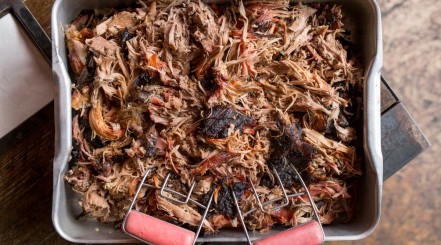
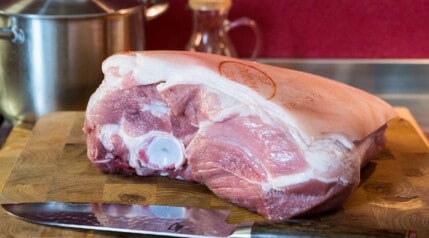


Hey Mark, this was really helpful. I wanted to know if I could reheat my pulled pork leftovers (again) and this post answered the question. It’s saved me time cooking another meal today, and instead be able to work on something I really needed to do this week! So thank you for taking the time to share your tips and knowledge, and giving me time in the process :). Jay
Glad it helped, Jay. Thank you, 🙂
Hello! Once you wrap it in the foil, around how long would it take to heat up in an oven roster??
Hi Christine,
This can depend on so much, such as how moist the meat is, any liquids added, overall weight, size and shape of what’s being reheated (thickness in inches and hence how long heat takes to get to the center) so it’s very hard to judge and is why I added to cook to a temperature, not a time. I use my smoker thermometer, probe into center and have the wire coming out of the top of the oven door into thermometer unit and just go by temp.
An emergency caused me to remove a Boston Butt from the smoker at 170 degrees. I left it whole, wrapped in foil and refrigerated it overnight. Can I put in the oven until it reaches the desired 200 degrees internal, rest it, and shred it for “pulled pork”?
Hi Michael,
Yes, this would be fine as long as it’s still ‘fresh’ when removed from the fridge (i.e. not left in there for weeks, and it turns!).
The fact it was taken to 170 degrees will have killed all surface germs, and it’s been refrigerated, so no new ones should have grown — and it was smoked until 170, with smoke on the surface being a preservative. The fact it was wrapped before cooling will have kept as many juices in as possible, and having only been taken to 170f, the connective tissues will not have melted, and all the fat will not have rendered out, plus the fact a butt is so fatty and forgiving a cut to smoke I’m sure it will still be moist after resuming cooking.
I guess it won’t be quite as good as if it was cooked right through in one go, instead of a pause and refrigeration mid-process, but I’d also be willing to bet in a blind taste test if it was put up beside one cooked right through, that very, very few people would be able to tell the difference, especially after pulling it and adding sauce.
Why is there a difference in temperature depending on the reheating method? For the crock pot method it is 140, but for microwave it is 165? What if the whole shoulder is put away at 40 for a few days? Is it better to pull it and then heat it or heat it and then pull it?
Hi, Leva,
That is a very good question…and I don’t have a solid answer! The times and temps were taken from other peoples advice and curated into this content. However, after you pointing out the discrepancies, it’s made me think:
All ‘official advice’ is to make sure reheated meat is taken to above 165f. And as a public facing website, I have to agree and MUST also state this, otherwise I could potentially put people in danger if they reheat food unsafely!
Therefore, I have just gone back through the article and updated all temps to 165F reflect this.
The thing is, many people in BBQ / smoking circles argue that meat which has been rubbed (containing salt) and smoked — such as pork butt normally is — has effectively been preserved, because salt and smoke have been used to preserve meat for centuries (or millennia?), so it doesn’t have to be taken to too high a temperature to kill bacteria, the salt and smoke keeps them away. And they like to not go so high, because there’s danger of the meat being dried out further.
This might be partially true. However, pork butt is so fatty and moist, it will not dry out.
But more importantly, there is the issue that the meat has been pulled, the insides exposed, and most of the inside has NOT been in contact with salt or smoke, so can easily pick up and grow bacteria (in my opinion.)
So I agree that the meat should be taken up to 165F and I have changed the article to be in line with this.
Can you please tell me how to keep my Christmas pork moist if I cook and slice the day before?
Hi Debbie. Sorry for the late reply, I took time off over Xmas as I was traveling and wasn’t able to reply to comments.
A good way is to store it with some cooking juices, and also to reheat it with the juices, using one of the methods described above.
However, depending on the pork joint (or more to the point, if NOT a pork butt) it is likely cooked to a lower temp than a pork butt (probably 145f), then sliced, stored and reheated, and during this process, it will lose some moisture and quality sadly. Pork butt is VERY forgiving, other cuts not so much.
I just bookmarked your website.
Excellent, see you again soon 🙂
This is such good information!!
If I smoke a pork butt, immediately wrap it in foil without shredding it, and put it in a cooler with ice, could it stay “good” for 3 or 4 days before eating it? I thought I’d bring a Crockpot to heat it back up to 165 or put it on the grill. Thoughts?
Thank you!
Hi Chelsea,
Yes, it will certainly be good for 3 or 4 days if wrapped airtight and refrigerated. I’ve kept them a fair bit longer than that with no issues!
I have a large pan with 10 lbs of chopped pork butt that has been refrigerated. How long & what temp do I reheat the meat in the oven.
Hi Janet,
225 F oven, until the temperature in your sealed pork dish is 165 F or above. So you need to use a thermometer to know when it’s done.
Can’t really say a time, because it’s temp we’re aiming for. And it will take different amounts of time depending on how thick the layer of pork is, how much fat content it has, what other liquid(s) were added, etc.
Hi there,
Thank you for sharing so much information. I understand using temperature as the mark of when the pork has reheated to yum status in the oven…
As I prep for the day and create a schedule… I’m wondering if you could offer a ball park idea of time for me…
At 225* it’ll take a few pounds of porks that’s been shredded somewhere around…. 30 mins, 2 hours, 5 hours to reheat.
I’ll def use the thermometer to id the 165 but am seeking just a gauge of how to stack my other dishes.
Thanks for your consideration and time.
Rachelle
Hi Rachelle,
It depends on the overall shape and more particularly thickness of the pulled pork you are reheating. The thinner it is, the more easily the heat can get to the center, the thicker it is, the more time heat takes to reach the center.
I tend to portion my pork off and vacuum seal it in quite thin bags, so that sous vide takes an hour or less.
If reheating in an oven, I make sure to use a large dish, or a large foil packet, and make sure the pork is spread out reasonably thin. It then takes only half hour or so to reheat. If I need to reheat more than a thin layer will allow, I use numerous dishes, or make numerous packets, utilizing multiple shelves in my oven, to still keep the required time down.
Hi Mark,
I have a whole 7 Lb fully cooked smoked pork butt in the freezer that I purchased frozen for a charity drive. I didn’t need it right away, so I put it in the freezer. What is the best way to reheat it?
Thanks, Mark.
Hi David,
You should thoroughly defrost in the fridge first, which for a 7lb butt, I would give at least 30 hours.
Then to reheat it, it depends on what you are planning to do with it, but I would assume you will shred it for pulled pork? If so, after it’s fully defrosted, I would slice, tear, and pull the thing apart, remove the bone, and simply follow any of the methods above. It is already pre-cooked, so shredding allows you to reheat as described in this article.
If you are planning to reheat it whole, then slice and serve it (instead of pulling), you will want to slowly bring it up to 165 °F internal temp by wrapping it in aluminum foil and placing it in a low and slow grill, smoker, or even kitchen oven, set to between 250 and 300 °F. Make sure it’s wrapped TIGHT (sealed), or you risk drying it out.
Hello. I just purchased a smoked Boston butt (was 15lb) cooked down to about 9lbs. I don’t plan to serve until tomorrow late afternoon. It’s resting now and as soon as it’s cooled I will place in refrigerator. Promise, I’m getting to my question. Once I take it from fridge tomorrow (will allow several hours get the chill off) by placing on countertop. I have a crockpot that simmers. How long and what temperature should I simmer it before serving hot? Should I add sauce when I place in pan? Thank you in advance
I’ve never used a crockpot, but think you should be able to follow the instructions for sous vide from above.